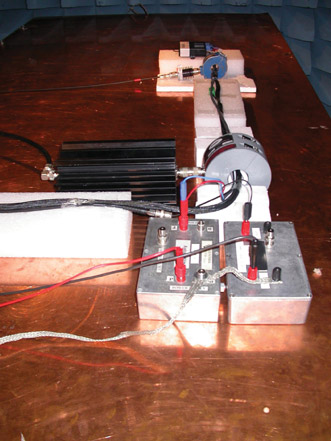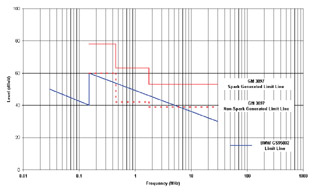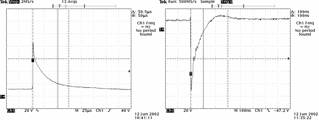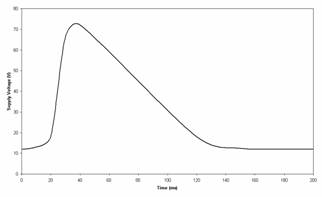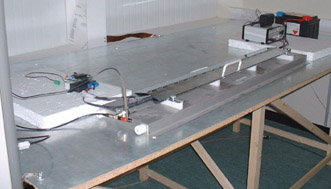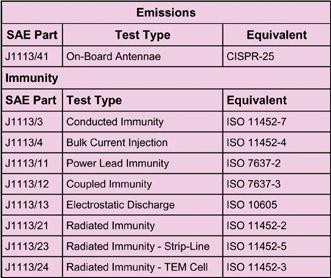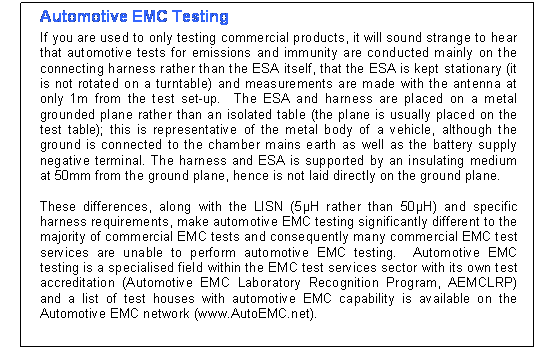|
EMC Test Standards for Automotive Electronic Components
By Martin O'Hara, Senior Design Consultant, Telematica Systems Ltd
Introduction The electronics content of vehicles has been increasing dramatically, particularly over the last 15 years or so and is predicted to continue into the next decade, some estimates suggest the value of electronics in a medium sized vehicle will represent 30% of the total vehicle cost by 2010. The increase in vehicle electronic components and modules has occurred not only in electronic control units (ECU) for the vehicle itself, but also more recently in mobile communications, information, security and entertainment systems in the vehicle.
In light of this growth it is important that the multiple ECU’s in a vehicle are compatible electromagnetically and will not interfere with off-board systems (especially roadside equipment). The EMC of vehicles, especially spark ignition engines, has been a consideration globally for much longer than most commercial EMC standards have existed. In Europe the first directive for the suppression of spark-ignition noise was published in 1972 (72/245/EEC). In North America the Society of Automotive Engineers (SAE) have had standards available on EMC since the early 1990’s and the International Standards Organisation (ISO) and CISPR have provided automotive specific EMC standards since 1990.
In the European Union (EU) there is a specific directive for automotive EMC (EU directive 95/54/EC which amends 72/245/EEC) that covers the majority of automotive assemblies as well as the vehicles themselves and is embodied in legislation (several non EU member countries in Europe also adopt this directive under regulation ECE 10.02). There is no similar legislative equivalent in North America (USA and Canada) or the Rest of the World (RoW), hence automotive OEM’s have developed their own internal standards that allow them to meet the requirements of all the geographic markets into which they sell. Consequently the field of automotive EMC testing may appear complicated having many different standards, some specific to OEM’s, some international (CISPR/ISO), some geographic (SAE in North America) and some legislative requirements (95/54/EC).
Table 1: International Automotive Standards for Component Testing Components or Electronic Sub-Assemblies The term “electronic sub-assembly” (ESA) refers to almost any electrical or electronic device fitted to a vehicle. The definition includes the more obvious sub-systems such as engine management unit (EMU), body control modules (BCM) and heating, ventilation and air-conditioning (HVAC) systems. The term ESA also includes what might be otherwise considered as components such as manifold absolute pressure (MAP) sensor, solid-state relays (SSR) and motors. The international automotive EMC standards usually refer to both components and modules as electronic sub-assemblies and here no difference will be made between them, although most of the discussion will be based on modules rather than single components. There are two categories of electrical/electronic equipment fitted to vehicles; those fitted by the vehicle manufacturer (OEM fit) and after-market equipment (user fitted or professionally installed). In many cases the same companies are supplying the OEM and after-market product and these will be tested to the same EMC standards. Equipment intended as after-market fit only may not be as well regulated with respect to EMC as OEM fitted and will generally only meet the minimum requirements for the market. Radiated Emissions Standards The two radiated emissions standards in common use; 95/54/EC and CISPR-25, share many common features in their chamber (Absorber Lined Screened Enclosure; ALSE, figure 1) test set-up and the results of each are almost comparable. The “almost” is due to minor and often annoying discrepancies, for example CISPR-25 tests for radiated emissions specifies the ground plane at 0.9m from the chamber floor, 95/54/EC specifies 1m. It is also possible to do the tests on an Open Area Test Site (OATS) instead of a chamber, but the calibration for OATS is significantly more time consuming and consequently more expensive via a test service, hence the preference for ALSE facilities for these tests.
Figure 1: Radiated Emissions measurements from an automotive ESA (satellite navigation display) and harness (photo courtesy of Trafficmaster/3C Test Ltd)
The 95/54/EC standard covers the frequency range 30MHz to 1GHz with fixed test levels for broadband and narrowband emissions (figure 2). The levels are contiguous across the frequency range and are simple pass/fail limits, although as with most EMC test the “absolute” limits are complicated by the standard insetting by 2dB on the quoted reference levels. Most people test to the quoted limits directly, it is only when an emission is close to the reference limit that the 2dB inset level is used, and if submitting for type approval the final word is provided by the approval body (the VCA in the case of UK tested products). It is not necessary to test at all the frequencies in the range 30MHz to 1GHz, the directive allows for the selection of 13 test frequencies across this range (within 13 defined frequency bands), however, as these test frequencies are selected from the largest excursions during a pre-scan, it is usual to sweep the whole frequency range rather than select test points.
Figure 2: PSA and Ford limit lines extending the test frequency to 2GHz
CISPR-25 covers a wider frequency range (150kHz to 960MHz) and has broadband and narrowband limits (broadband includes peak and quasi-peak detector limits). The test levels are not continuous across this frequency range, instead being applied only to utilised radio frequency bands (figure 3). In CISPR-25 there are five classes of limit that can be applied, often the customer will specify these, if no specific customer requirements (i.e. for the after-market) then the manufacturer often performs the tests and applies whatever limit the ESA passes.
Figure 3: CISPR 25 Broadband peak and 95/54/EC limit lines CISPR-25 includes provision for testing radiated emissions in a TEM cell. The test can be performed up to 175MHz only and includes seven classes of limit lines. The levels are equal across all the measurement bands in the TEM cell test for each class limit. This type of testing is typically performed in-house rather than at a test service, as the wider frequency range and ability to test to 95/54/EC at the same time makes the chamber a more appealing test solution for test service providers as well as manufacturers.
OEM specifications are based around the CISPR-25 chamber set-up (some also allow the TEM test for the lower frequency range). Most fill in the missing measurement bands, however, there is no consistency between OEM on how this is performed. For example PSA fill in the intermediate measurement bands below 30MHz with the lower limit level from the previous band (i.e. if class 4 is applied from 150kHz to 300kHz, class 3 limit from this band is applied from 300kHz to 530kHz), above 30MHz the 95/54/EC limits plus 10dB is used in the gaps. Ford applies their own (non-CISPR-25) limit level and only utilise the test set-up of the standard. Most OEM specifications extend the upper frequency range, going to 2GHz to cover GSM frequencies at 1.8GHz and 1.9GHz, a few extend further to 2.5GHz and 3GHz to encompass Bluetooth technologies. Radiated Immunity Standards There are two radiated immunity standards in common use; 95/54/EC for European legislative purposes and ISO 11452 for most OEM standards. There are common tests between the two standards and both allow a variety of methods to be employed in the testing. One common test component is the use of amplitude modulation (AM) at 1kHz to a depth of 80% that is used for both test standards discussed here.
Figure 4: Automotive ESA (EMU) radiated immunity testing in a 150mm stripline (photo courtesy of Motorola)
The EU directive 95/54/EC permits testing using both 150mm and 800mm striplines, TEM cell (up to 200MHz), bulk current injection (BCI) and free-field (ALSE). Each test method has different limits and the directive specifies that tests should be at 25% above the defined limit (table 2). Testing across the complete frequency range required by 95/54/EC (20MHz to 1GHz) is complicated if any method other than free field is used, as most of the other test methods are difficult to calibrate above 400MHz. As with the radiated emissions testing, it is permissible to test at specific test points (14 test points required, frequency bands not explicitly defined).
Table 2: Immunity Limit Levels as defined in 95/54/EC
ISO 11452 comes in 7 parts the first of which is the general definitions, the other 6 are different test methods and limits comprising of free field (ALSE), TEM, BCI, 150mm stripline, parallel plate antenna and direct RF injection (table 3). As with most international standards there are multiple classes of limit levels that the manufacturer or customer can specify; typically there are 4 defined classes within each test method and a “user defined” class without limits. Although limit levels do vary by test method, the classes encompass the range 25V/m to 200V/m for direct field measurement methods, 25mA to 100mA for BCI and 0.1W to 0.5W for direct injection.
Table 3: ISO 11452 Test Methods and Frequency Range
Figure 5: BCI testing over ground plane (photo courtesy of Trafficmaster/3C Test Ltd) The OEM standards primarily utilise the methods and limits of ISO 11452. It is not uncommon for multiple immunity tests to be specified with BCI often used for the lower frequency (1 to 400MHz) and free field for tests from 20MHz to the upper defined frequency limit. There are many OEM specifications that extend beyond the 1GHz limit of 95/54/EC, however, few require testing to the upper frequency limit of 18GHz as defined in ISO 11452-2 (General Motors extend to 10GHz) and most have upper limits concurrent with their radiated emissions specification (i.e. typically in the 2GHz to 3GHz range). The OEM tests also use continuous wave (CW) tests as well as AM, and many include pulsed modulation (PM), in place of AM, at higher frequencies (above 1GHz). Conducted Emissions CISPR-25 is the primary automotive standard for conducted emissions, containing tests and limit levels for both power and signal line conducted noise. Automotive radiated emissions testing is to ensure the ESA, and hence completed vehicle, does not interfere with equipment external to the vehicle as well as on-board receivers, automotive conducted emissions tests are purely to ensure the ESA does not interfere with other on-board equipment. The wired supply and signalling system for a vehicle is a self contained system and does not directly interface with off-board equipment while in use.
There are two test methods for conducted emissions in CISPR-25; measurements via a LISN (50W/5µH) for power line emissions (figure 6) and measurements from a current probe for signal/control line emissions. There are again 5 classes of limit lines (as per radiated emissions in CISPR-25) and again broadband and narrowband limits, with peak and quasi-peak detector limits for the broadband measurement. The conducted emissions test covers the frequency range 150kHz to 108MHz, with five specific radio frequency bands.
Figure 6: Testing the conducted emissions of ESA power lines via 50W/5µH LISN (photo courtesy of Trafficemaster/3C Test Ltd)
As with radiated emissions, OEM specifications utilise the test set-up of CISPR-25 for power line emissions and apply their own limits, most filling in the omitted test bands. A few of the OEM specifications extend the test frequency range (e.g. BMW cover 30kHz to 120MHz, figure 7). Signal/control line testing is not as universally well specified, many OEM specifications use methods not covered by the CISPR-25 standard and some omit testing noise on these lines other than at audio frequencies.
Figure 7: General Motors (GM) and BMW conducted emissions limits for power lines
Conducted Immunity Conducted immunity to transients standard (ISO 7637) contains some of the most fundamental test methods to ensure that an ESA can function within an automotive electrical environment. Although this standard has no current statutory requirement, it is one of the most basic “good practice” tests that should be applied to any ESA.
The ISO 7637 standard is currently under review, at the present time it comes in 3 parts, the first for 12V systems, second for 24V systems and third for signal/control line immunity. The ISO review has already re-issued the first part as a general definitions paper and will combine the 12V and 24V testing into the second part with the signal/control testing probably retained in part 3. There are different transient pulses that will be retained and/or dropped in the review and consequently the discussion here is more general that in previous sections as the finalised test standards are not yet published.
The transient immunity standard encompasses noise that is likely to be observed on the power and signal lines of an automotive wiring network. These include inductive noise from motors, supply dropout during cranking and load dump; where the battery is disconnected while the alternator is still running. There are four classes of limits applicable within the standard, as well as the usual “customer specified” level. Power line transients (figures 8 to 10) are applied directly onto the power supply, the signal/control line transients are coupled capacitively via a coupling clamp (figure 11).
Figure 8: Inductive transient noise applied to 12V power supply lines
Figure 9: Transient during cranking on 12V power supply
Figure 10: Load dump transient on 12V supply line
Figure 11: Signal/control line transients test set-up using coupling clamp (photo courtesy of Trafficmaster/3C Test Ltd)
There are a series of functional classifications that are common to many ISO automotive standards (see text box). The functional categories allow a product to either operate continuously during a transient event or to simply survive a transient while not functioning during the event. The functional classification is obviously determined by the application an ESA is intended for, a powertrain ESA would be expected to operate during transients (class A), whereas a telematic unit can cease functioning during the transient and recover after the event (class C).
OEM specifications use the pulses and set-up of ISO 7637 with their own set of applied levels and functional classifications. The OEM specifications modify some of the pulse shapes to be specific to the power network, motors and alternators typically used in their vehicles, hence are similar to ISO 7637 with minor nuances in the voltage levels and pulse shapes (rise times and dwell times are usually different between OEM specifications). Immunity to Electrostatic Discharge (ESD) The vehicle is an isolated product in that it does not share a current return common with the “earth” reference. The current reference to ground on a vehicle is usually to the negative terminal of the battery, hence is not the standard ground reference of most commercial tests or products. Consequently a different body model and test standard has been developed for automotive ESD testing; ISO 10604.
Figure 12: ESD testing ESA at connector while powered (photo courtesy of Trafficmaster/3C Test Ltd)
The body model uses a 2kW series resistor and 150pF capacitor for discharge while outside a vehicle and 330pF capacitor for discharge inside a vehicle. There are the usual air and direct contact discharge tests to both the ESA body and to the connectors and/or any metal fixings. The standard also includes testing for air and contact discharge at the electrical terminals of the ESA while unpowered (i.e. no ground return) to simulate handling during assembly, this requires any accumulated charge to be bled from the ESA between applied discharges.
The discharge levels cover ±2kV up to ±25kV, the higher levels primarily reserved for equipment classed as pyrotechnic, this includes airbag deployment devices and in some OEM specifications fuel systems. The minimum number of discharges is specified as 3 per polarity with at least 5s between applied test pulses. The standard includes the usual ISO functional classifications (see text box).
The automotive ESD standard is almost universally adopted within OEM specifications. A few OEM specifications use the commercial body model definition of IEC 61000-4-2 (330W series resistor), it is difficult to know whether this is an error by the OEM or a deliberate effort to apply a higher stress to an ESA? Not all OEM specifications currently include the un-powered test as this is a relatively new addition to the standard (updated in December 2001).
Society of Automotive Engineers (SAE) Standards The SAE have been the leading influence in producing standardisation for the North American automotive market. Their standards reflect what the “big 3” US OEMs (General Motors, Ford and Chrysler) were doing in the last decade, before some of the standards were adopted by the international standards community (and before Chrysler were merged with Daimler-Benz). The majority of SAE standards are now encompassed in international standards and although still often quoted for North American products, they are mainly superseded by their ISO and CISPR equivalents.
Table 4: SAE Standards for Component Testing and their International Equivalent
There are some SAE component standards that have not been adopted by the international standard bodies. Some of the unadopted SAE standards are encompassed in a few of the OEM specifications, however, many of these are being dropped in favour of alternative tests that are encompassed by existing international standards and consequently are not included here.
The SAE standards were developed to allow North American suppliers to produce compliant products for their home OEM market. With most of the SAE standards now covered by international equivalents it is debatable whether there is a need for the SAE standards to be separately maintained and updated.
Choice of Test Standards Assuming that an OEM standard has not been provided (i.e. a product is not designed for OEM line fit), then the choice of applicable standards is open to interpretation, with the exception of products for sale in Europe.
In Europe the choice of standard for radiated emissions and immunity is determined by legal requirements. It is required to show proof of meeting the standards and to “e” mark an ESA via the type approval process of 95/54/EC. This is the minimum requirement for sale of a product intended for automotive use in the EU, however, it would be sensible for a manufacturer to also test for transient immunity, ESD and conducted emissions to ensure that the ESA will not cause problems for the customer and consequently give them a “bad name”.
The following are recommended test standards to use for three geographic regions where no OEM specification is available. Due to the legal nature of the European standards, if an ESA is to be sold in multiple regions it should tested to the European standard 95/54/EC as a minimum, others can be added at the request of regional authorities.
ESA Test Standards by Geographic Market
Table 5: European EMC Test Standards
The above are not all legal requirements, only 95/54/EC is legally required and for an ESA that does not effect the operation of the vehicle the radiated emissions test is the only legal requirement.
Table 6: North American EMC Standards
The above standards are not compulsory but again indicate sound engineering practice has been considered in the design of products intended for this market.
In the US automotive products are explicitly exempt from FCC Part 15 rules under section 15.103 Exempt Devices; “a) A digital device utilized exclusively in any transportation vehicle including motor vehicles and aircraft.”
Table 7: Worldwide EMC Standards
Products tested to these standards would be acceptable in the North American market as the SAE standards are equivalent.
Martin O'Hara is Senior Design Consultant, Telematica Systems Limited and can be contacted on tel: +44 (0)1234 759232, or email: martin@tmsl.com
|







